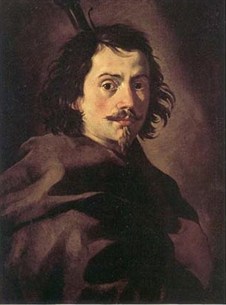Francesco Borromini
 Francesco Castelli, better known as Francesco Borromini (1599-1667) was born in Bissone, in the Canton of Ticino. He started working in Milan, where he probably worked as a stonemason in the Fabbrica del Duomo. At the end of 1619 he went to Rome, where he would be the author of some of the most original masterpieces of Baroque art. In contrast to naturalism and historicism of Bernini, Borromini proposed to re-establish architecture as a rigorous discipline, full of ethical tensions and symbolic meanings. With his works he introduced novel spatial “inventions”, such as the elliptical plan, the modulation of walls and the scenic arrangement of sources of light. Among his masterpieces are the San Carlino alle Quattro Fontane (The Church of Saint Charles at the Four Fountains), the Oratorio dei Filippini (the Oratory of Saint Philip Neri), the Churches of Sant’Ivo alla Sapienza (Saint Yves at the Sapienza) and Sant’Agnese (Saint Agnes) in Piazza Navona, the palace of Propaganda Fide, the dome and the bell tower of Sant’Andrea delle Fratte. On behalf of Pope Innocent X he also worked on the restoration of the Basilica of Saint John Lateran.
Francesco Castelli, better known as Francesco Borromini (1599-1667) was born in Bissone, in the Canton of Ticino. He started working in Milan, where he probably worked as a stonemason in the Fabbrica del Duomo. At the end of 1619 he went to Rome, where he would be the author of some of the most original masterpieces of Baroque art. In contrast to naturalism and historicism of Bernini, Borromini proposed to re-establish architecture as a rigorous discipline, full of ethical tensions and symbolic meanings. With his works he introduced novel spatial “inventions”, such as the elliptical plan, the modulation of walls and the scenic arrangement of sources of light. Among his masterpieces are the San Carlino alle Quattro Fontane (The Church of Saint Charles at the Four Fountains), the Oratorio dei Filippini (the Oratory of Saint Philip Neri), the Churches of Sant’Ivo alla Sapienza (Saint Yves at the Sapienza) and Sant’Agnese (Saint Agnes) in Piazza Navona, the palace of Propaganda Fide, the dome and the bell tower of Sant’Andrea delle Fratte. On behalf of Pope Innocent X he also worked on the restoration of the Basilica of Saint John Lateran.
